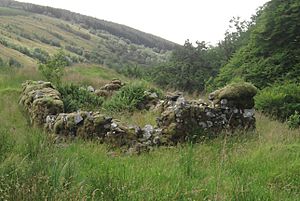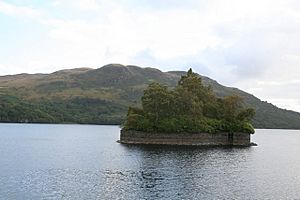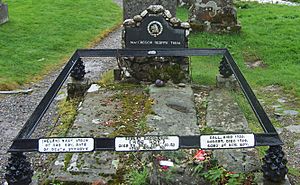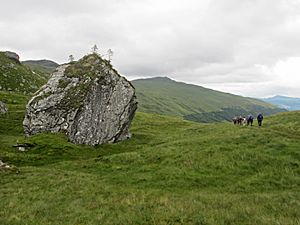Rob Roy MacGregor facts for kids
Quick facts for kids
Robert Roy MacGregor
|
|
|---|---|

An engraving of Rob Roy, ca. 1820
|
|
| Born |
Robert MacGregor
7 March 1671 Loch Katrine, Perthshire, Scotland
|
| Died | 28 December 1734 (aged 63) Balquhidder, Perthshire, Scotland
|
| Nationality | Scottish |
| Other names | Robert Campbell (alias) Rob Roy |
| Occupation | Soldier, cattle dealer |
| Known for | Scottish folk hero |
| Children | 4 |
Robert Roy MacGregor (Scottish Gaelic: Raibeart Ruadh MacGriogair; March 7, 1671 – December 28, 1734) was a famous Scottish figure. He was known as an "outlaw," meaning someone who lived outside the law. Later, he became a "folk hero," a person admired by many for their bravery and actions.
Contents
Rob Roy's Early Life
Rob Roy was born in Scotland, near Loch Katrine. His parents were Donald Glas MacGregor and Margaret Campbell. Donald was a "Tacksman," which meant he managed land for his clan. Rob Roy was also part of the Clan MacDonald of Keppoch through his grandmother.
In January 1693, Rob Roy married Mary MacGregor of Comar. They had four sons: James, Ranald, Coll, and Robert. Their youngest son, Robert, was often called Robìn Òig, or Young Rob.
Rob Roy and the Jacobite Risings
When Rob Roy was 18, he joined a group called the Jacobites. Many other Scottish clansmen also joined. They supported King James VII, who was part of the House of Stuart royal family. King James had left Britain after the Glorious Revolution of 1688.
The Jacobites won some early battles, but their leader was killed. Rob Roy's father was put in jail for two years because he supported the Jacobites. Sadly, his mother became very ill and passed away while his father was in prison.
Protecting Cattle Herds
Like many other Scottish clan leaders, Rob Roy helped protect cattle herds. He offered a "Watch" service to wealthy landowners. In return for money, he would make sure their cattle were safe. If any cattle were stolen, he would either get them back or pay for them. This money helped feed his family and his clan.
Rob Roy was a respected cattleman. At that time, protecting cattle and selling protection against theft was a common way to earn a living. Rob Roy borrowed a lot of money to buy more cattle. However, the person he trusted with the money disappeared. This meant Rob Roy could not pay back his loan.
Because he couldn't pay, he was declared an outlaw. His family was forced out of their home, which was then burned down. The Duke of Montrose, who was Rob Roy's main creditor, took his lands. After this, Rob Roy began a long conflict with the Duke. He would raid the Duke's cattle and steal his rent money.
Another story says that Rob Roy lost his lands because he was involved in the Jacobite rising of 1715. The Duke of Montrose then bought the land in 1720.
Life in Glen Shira



In 1716, Rob Roy moved to Glen Shira. He lived there under the protection of John Campbell, 2nd Duke of Argyll. This Duke was also known as Red John of the Battles. Argyll helped Rob Roy get an "amnesty," which meant he would not be punished for his past actions. Rob Roy was allowed to build a house in the Glen if he gave up his weapons. People say that Argyll only received a pile of old, rusty weapons!
A special pouch and a small knife (called a "dirk") that belonged to Rob Roy can still be seen at Inveraray Castle. Rob Roy only used this house sometimes for a few years.
In July 1717, Rob Roy and his entire Clan Gregor were specifically excluded from a law that pardoned everyone else who took part in the 1715 Jacobite rising.
Rob Roy also took part in the Battle of Glen Shiel in 1719. In this battle, a British army with Scottish allies fought against Jacobite Scots and their Spanish supporters. The British won the battle. Some stories say Rob Roy was hurt, but this is not certain.
Around 1720, Rob Roy moved to Monachyle Tuarach. Before 1722, he finally settled at Inverlochlarig Beag in Balquhidder.
Rob Roy's Later Life
Rob Roy's conflict with the Duke of Montrose continued until 1722. At that time, Rob Roy was forced to give up. He was later put in prison but was finally pardoned in 1727.
Rob Roy passed away in his home at Inverlochlarig Beg, Balquhidder, on December 28, 1734. He was 63 years old. He died after an illness, likely due to old age and a harsh winter.
One account suggests that Rob Roy decided to become a Roman Catholic before he died. He supposedly went to an old priest named Alexander Drummond. This account suggests Rob Roy did this because he felt sorry for his past actions.
Rob Roy's Legacy
Glengyle House, near Loch Katrine, was built in the early 1700s. It stands where Rob Roy's childhood home was. This historic building was put up for sale in 2004.
The Rob Roy Way is a long walking path created in 2002. It stretches from Drymen to Pitlochry and is named in Rob Roy's honor.
Some of Rob Roy's family members settled in McGregor, Iowa, in the United States. In 1849, it was said that Rob Roy's original clan seal and ring were owned by Alex McGregor in Iowa. The clan seal had a Gaelic saying: "S' Rioghal Mo Dhream," which means "Royal is my race."
In 1878, a football club called Kirkintilloch Rob Roy F.C. was started and named after him.
Early settlers in New Zealand named Roys Peak and Rob Roy Glacier to honor Rob Roy MacGregor.
See also
 In Spanish: Rob Roy MacGregor para niños
In Spanish: Rob Roy MacGregor para niños
- Auchenbathie Tower
- Clan Gregor
- Gilderoy (outlaw)
- Rob Roy (dog), a famous pet collie of US First Lady Grace Coolidge


